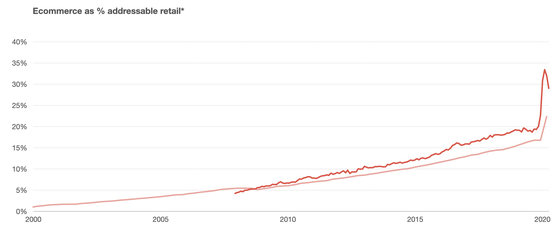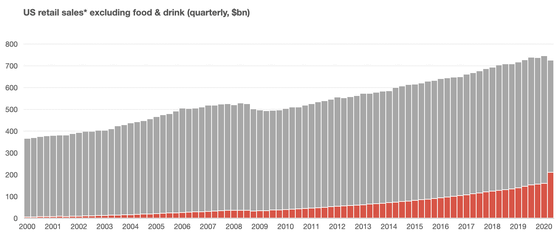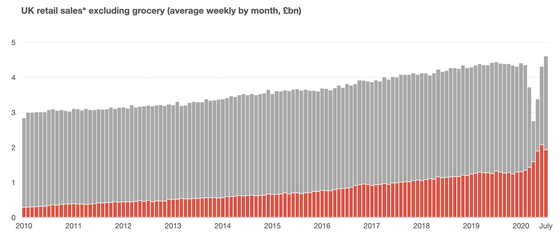How much did the new Corona increase online shopping sales?

The epidemic of the new coronavirus infectious disease (COVID-19) has increased the proportion of people who spend their time at home refraining from going out, and
The ecommerce surge — Benedict Evans
https://www.ben-evans.com/benedictevans/2020/8/18/the-ecommerce-surge
Demand for e-commerce is expanding around the world, such as Amazon's announcement that 'quarterly profit has doubled from the previous year' in response to increased nesting demand from COVID-19. Regarding how the demand for such e-commerce has increased, the United States Census Bureau and the British National Bureau of Statistics have published statistical information on the changes in e-commerce sales in their respective countries. This Evans' commentary is based on official announcements from both the US and UK Statistics Bureaus.
Below is a graph on the e-commerce penetration rate announced by both the US and UK Statistics Bureaus. The horizontal axis shows the period and the vertical axis shows the proportion of e-commerce in retail sales. The red graph is for the United Kingdom and the pink graph is for the United States. Since 2000, the e-commerce penetration rate has continued to rise gently, but the situation has changed dramatically due to the COVID-19 epidemic in early 2020. In just two months, e-commerce penetration jumped from 20% to over 30% in the UK and from 17% to 22% in the US.

The rapid increase in the e-commerce penetration rate is due not only to the 'ecommerce sales surge,' but also to the 'in-store sales decline.' Below is a graph of products excluding food products in the United States, where the red bar graph shows e-commerce sales and the gray bar graph shows in-store sales. The red bar chart shows a sharp increase in 2020, and you can see that e-commerce sales surged, while the gray bar chart fell in 2020, which means that sales at physical stores decreased I understand.

Both the United States and the United Kingdom have issued curfew, but Britain is prohibited from going out except for the purchase of daily necessities, and has taken

The figure below shows the ratio of e-commerce to sales in the United Kingdom by non-food items (dark blue graph), food items (pink graph), and total sales of food items and non-food items (red graph). Around April 2020 when the curfew was issued, the penetration rate of e-commerce in non-food products has jumped from 30% to just under 60%, but in July 2020 it has returned to just over 40%. .. On the other hand, the penetration rate of e-commerce in food products has doubled from 5% to 10% due to curfew, and has remained almost flat since then.

The COVID-19 epidemic basically reduced sales at physical stores, with the exception of grocery sales in the UK. The chart below shows physical store sales (gray chart) and e-commerce sales (red chart) for UK food products. Due to the “hoarding demand” created by the prohibition on going out, the sales at the actual stores increased rapidly, and since the eating out was banned thereafter, the sales of food products at the actual stores are higher than usual. In addition, food e-commerce sales have doubled.

The restrictions on going out have hit the retail industries such as home appliances and apparel. The changes in sales of the home appliance industry (pink dashed line graph), apparel industry (red solid line graph), and department stores (grey dashed line graph) are as follows. Sales of each of these are halved, but sales in the apparel industry in particular have fallen to less than one-fifth.

Regarding these graphs, Evans said, 'By January 2020, everyone thought, 'I wish I could buy anything online,' but now there is no option other than online purchase. It means that the future of shopping, which you can reach naturally, has arrived early with COVID-19.There are various attempts at online shopping, and it seems that some may not be established, but after six months it will result. Will be issued.'
Related Posts:
in Web Service, Posted by darkhorse_log







